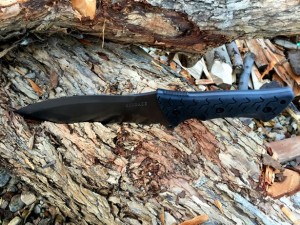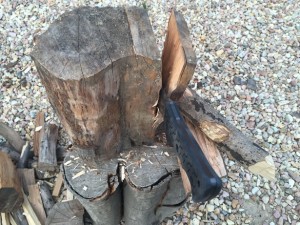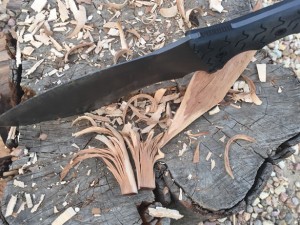Schrade SCHF28 Little Ricky Fixed Blade Knife Reviewed

Marketing from Schrade
Schrade’s Little Ricky Full Tang Fixed Blade Knife, Titanium Coated 8Cr13MoV High Carbon Stainless Steel Drop Point Re-Curve Blade Featuring Finger Guard with Hole and Choil, TPE Handle Slabs with Finger Grooves and Lanyard Hole, Nylon Fiber Belt Sheath with Grommet Holes.
With an overall length of just over 14 inches, there’s no job too big for the SCHF28! This titanium coated titan features a drop point, re-curve blade forged from super tough, edge holding 8Cr13MoV high carbon stainless steel. Weighing in at a well balanced 20.8 ounces, the SCHF28 arrives seriously sharp… and with the unrivaled strength of a full tang.
With an appetite for chopping… the re-curve design allows the blade’s belly to penetrate deep into even the hardiest of hardwoods. Use the finger choil in conjunction with the jimping along the spine of the blade for controlled carving… such as making feather sticks to light a campfire.
The textured, all-weather TPE handle slabs are well suited for the robust grip of the avid outdoorsman… with finger guard and hole promoting comfortable and safe, all-day chopping. The handle offers a lanyard hole for attaching cordage… or even ranger beads for keeping a pass count while in the backcountry.
The SCHF28 rides in a durable, multi-carry option thermoplastic belt sheath with grommet holes that allow essential gear—such as ferro rods—to be easily attached.
A re-curve drop point chopper ready to take on anything the backcountry cares to serve up… made from premium materials… and built for a lifetime. This is the Schrade SCHF28 full tang fixed blade knife.
Manufacturer: Schrade, www.schrade.com
Model: SCHF28
Overall Length: 14.07″ (35.74 cm)
Blade Steel: Titanium Coated 8Cr13MoV High Carbon Stainless Steel Blade
Blade Length: 7.94″ (20.17 cm)
Blade Thickness: 3/16″ (.476 cm)
Handle Material: TPE Handle Slabs with Finger Grooves
Handle Length: 6.13″ (15.57 cm)
Weight: 1.31 lbs. (20.96 oz)
Accessories: Nylon Fiber Belt Sheath with Grommet Holes
Warranty: Limited Lifetime Warranty against any manufacturing defects
Origin: China
MSRP: $75.00
UPC: 044356222235
The Review
Today I’m going to review Schrade’s SCHF28 Little Ricky Fixed Blade Knife which is part of their new 2015 lineup. With all of the machetes and blades that I’ve reviewed as of late, this is one that I’ve really been excited to put to the test.

Initial Thoughts
Pulling Schrade’s SCHF28 Little Ricky out of the box for the first time, I had to ask myself… Is this thing a small machete or a large survival knife? This blade is undeniably huge and would certainly be quite intimidating to an attacker. But not so much that it is difficult to wield, and it is very well balanced for its size and weight.
The nylon-fiber belt sheath feels extremely durable and holds the SCHF28 firmly in place without any rattle whatsoever, with or without the hook and loop strap locking it down. The molded belt loop is capable of accommodating an 1-3/4″ belt and there are grommet holes and 1-1/4″ strap slots along each side providing additional mounting options.
The SCHF28 features an 8″ titanium-coated 8Cr13MoV High Carbon Stainless Steel blade featuring an attractive swedge along the blade’s spine with a large drop-point and recurve yielding a blade width of 2-3/8″ at its widest point. The drop-point and recurve are so extreme that it has some resemblance to the shape of a Kukri machete. This adds quite a lot of mass to the blade which translates into enhanced chopping power.
The full-tang blade is covered by two removable black textured TPE slabs with lanyard hole at the end. The TPE handle combines an attractive non-slip pattern with an an ergonomic shape that is both comfortable and easy to wield in any weather condition.
The jimping on the blade’s spine adds traction and the finger choil in front of the finger guard are perfect for choking up on the blade when you need increased blade control.
Features
Now lets focus on the SCHF28’s features in more detail…
The Blade
The SCHF28 is made from a solid slab of 8Cr13MoV High Carbon Stainless Steel running through it from end to end. Its full-tang design provides the superior strength and rigidity that you would expect from any good survival knife.
8Cr13MoV is a Chinese stainless steel that is similar in quality to AICHI, AUS8 and 440B stainless steels with regard to strength, hardness, corrosion resistance and edge retention. Stainless steel is a popular class of material for knife blades because it has properties that are commonly resistant to rust and corrosion, while remaining easy to maintain. This makes it an excellent choice for a survival blade. While this alloy is typically easier to sharpen than other stainless alloys like 440C, it generally does not hold an edge quite as well.
 While the 8Cr13MoV High Carbon stainless steel and full-tang blade design are certainly tough enough to withstand a moderate amount of punishment, it is only rust resistant and not rust proof. Even with the protective titanium coating, it is still susceptible to rust without proper care and maintenance. If the blade becomes wet, simply dry it thoroughly and lightly coat it with a protective oil like Break-Free CLP before storage. If you do, it will likely last you a lifetime.
While the 8Cr13MoV High Carbon stainless steel and full-tang blade design are certainly tough enough to withstand a moderate amount of punishment, it is only rust resistant and not rust proof. Even with the protective titanium coating, it is still susceptible to rust without proper care and maintenance. If the blade becomes wet, simply dry it thoroughly and lightly coat it with a protective oil like Break-Free CLP before storage. If you do, it will likely last you a lifetime.
The SCHF28 has an aggressive convex drop-point profile with an exaggerated recurve and narrow-pointed tip. A drop-point profile is best explained as a blade with a convex curve from the spine to the tip of the blade which provides a strong, robust tip that is easy to direct when chopping, cutting and prying, but is often less suitable for piercing. However, in the case of the SCHF28, the spine has a long narrow-tapered swedge providing a longer point angle further improving its piercing capabilities.
Many blade types including the drop point, clip point, and even a hawkbill can have a recurve. A recurve is best described as a blade characteristic or feature rather than a blade shape. A recurve generally refers to a blade with a sweeping “S” shaped edge which are often used to help balance a large chopping blade as well as changing the blade’s angle in an attempt to improve its slicing, chopping and draw-cut capabilities.
The SCHF28 has a deep, hollow-grind and a slight compound bevel without any serrations. This is a very common grind on factory knives today. The shape of this blade provides a bit more leverage perfect for heavy bushwhacking tasks like chopping and lighter bushcraft techniques like carving and shaving sticks. Unfortunately, it can be somewhat challenging to sharpen with a stone due to the inward curve (or recurve) at the base of the drop-point.
Jimping is the term used for describing the small notches typically cut into the spine of a blade or put on the choil or other areas of a knife to prevent finger-slippage when wielding the knife. The SCHF28 has thirteen aggressive notches located on the top of the handle and a finger choil located in front of the finger guard which provide a wide variety of gripping options. However, in this case the jimping may be a little too aggressive for my taste.
The blade’s spine near the handle and the choil are both fixed at 90° angles with squared edges, perfect for striking a ferro rod, with or without the protective coating.
The Handle
The SCHF28’s TPE handle is a hard, durable rubber with an attractive pattern providing an excellent non-slip grip even in wet conditions. Thermoplastic Polyester Elastomer (TPE), sometimes referred to as thermoplastic rubber is made from a mix of plastic and rubber polymers providing both thermoplastic and elastomeric properties.
The two halves of the TPE handle are attached through the full-tang blade with two recessed allen bolts threaded directly into the knife steel allowing it to absorb much of the shock while chopping and batoning, thereby reducing fatigue. The handle is shaped with three finger cut-outs, tapered ends and a moderate palm-swell making it easy to hold on to with or without gloves.
The SCHF28 has two lanyard holes, each located at either end of the handle. One is located on the finger guard just behind the choil, and the other at the base of the handle. Each are sized perfectly for a paracord lanyard to provide a variety of tethering options.

The Sheath
The SCHF28 comes with a belt sheath made from an extremely durable moulded nylon-fiber. The SCHF28 fits snuggly in place without any rattle, with or without the Velcro strap holding it down. The molded belt loop is capable of accommodating a belt up to 1-3/4″ wide. Plus there are five grommet holes and two 1-1/4″ strap slots on each side of the sheath to accommodate various mounting options.
Functional Testing
Now lets see what the SCHF28 can do… In order to provide a some sort of apples-to-apples comparison between blades, I will be performing five durability tests; Batoning, Chopping, Feather Stick, Tip Strength and Edge Retention. In a survival situation, all resources are fair game. However, since I am not in a life-or-death situation, I’ll stick to some dead wood that I have lying around for these tests.
Batoning
Per Wikipedia: Batoning is the technique of cutting or splitting wood by using a baton-sized stick or mallet to repeatedly strike the spine of a sturdy knife, chisel or blade in order to drive it through wood. The batoning method can be used to make kindling or desired forms such as boards, slats or notches. The practice is most useful for obtaining dry wood from the inside of logs for the purpose of fire making.
Out of all of my usual tests, this is the one I am most concerned with. The SCHF28 has a long and deep swedge which looks great, but it translates into a very thin spine which is far from ideal for batoning. For this test I found a baton about 3″ in diameter and 18″ long.
Part one of the the baton test consisted of splitting a 4″ log into small kindling. To begin, I set up the first log on its end and placed the blade on top. Then I began to strike each end of the blade’s spine evenly with the baton as it steadily made its way through the length of the log. I split the log into many smaller pieces until I had a pile of similarly-sized tinder. As I had expected, the narrow spine dug into the baton, eventually causing the baton to break.
 For part two, the larger material that I chose to split was a bucked log nearly 12″ in diameter and a little less than 12″ long. Splitting larger material with a small axe or blade is typically performed by sectioning off 1-2″-thick slices from around the outer-edge of the log, parallel to the outermost rings. Then split them down further as necessary.
For part two, the larger material that I chose to split was a bucked log nearly 12″ in diameter and a little less than 12″ long. Splitting larger material with a small axe or blade is typically performed by sectioning off 1-2″-thick slices from around the outer-edge of the log, parallel to the outermost rings. Then split them down further as necessary.
After setting the log up, I began to work my way around by striking each end of the blade’s spine with the baton as before, slowly moving inward toward the center until the center core of the log was small enough to quarter.
As long as you don’t try to bite off too much at a time, the SCHF28 did split through the material quite well. The blade shape and grind is well suited for splitting. However, the narrow spine is not conducive to batoning causing in the baton to break repeatedly.
Chopping
To test the SCHF28’s ability to chop wood, I thought it would best to buck a small log into a few manageable pieces after delimbing it. Much like you would need to do if you were building a shelter or for creating a stockpile of firewood. I think this is as close as I can get to a real-world survival situation.
At a little over a pound, the thick-broad blade and exaggerated recurved edge of the SCHF28 generates a tremendous amount of cutting power with each swing. As a result, the SCHF28 easily cuts through smaller limbs, often with only a single swing. This made delimbing the log quick and easy.
To buck the log after delimbing it, you simply strike the log at a 45° angle from two perpendicular directions along the cut-line, effectively making a “V” in the material used to be, otherwise known as the kerf. The kerf should equal the diameter of the limb or trunk, and when cutting from both sides, the kerf would essentially be half diameter.
The perfect weight and balance of the SCHF28 coupled with its aggressive blade pattern and hollow-ground edge make it an effective chopping tool. With each swing, the SCHF28 bites deeply into the material causing the chips to go flying. Perfect for smaller material, a small handaxe would certainly be better for larger material.
Feather Stick
Per Wikipedia: A feather stick (sometimes referred to as a fuzz stick) is a length of wood which is shaved to produce a head of thin curls protruding from the wood. It is used for damp wood to start a fire (or campfire) when dry tinder is hard to find.
The next test is to create a feathered stick as a firestarter, and recurved blades are my typically favorite for this. I find the curved profile lends itself very well to generating the right amount of leverage and cutting force to make this task easy.
 The SCHF28 was certainly sharp enough right out of the box to perform well. With a douglas fir stick, I proceeded to shave curls as thin as I could manage around the base of the stick. The front-edge of the recurve seems to be the sweet-spot for shaving the curls. Before long I had a pile of finely-cut curls and a couple of feathered sticks.
The SCHF28 was certainly sharp enough right out of the box to perform well. With a douglas fir stick, I proceeded to shave curls as thin as I could manage around the base of the stick. The front-edge of the recurve seems to be the sweet-spot for shaving the curls. Before long I had a pile of finely-cut curls and a couple of feathered sticks.
Tip Strength
To test the SCHF28’s ability to stab and pierce without damage to the tip, I drove the tip of the blade into the end of a 12″ diameter stump as hard as I could. Then I loosened the blade using a side-to-side motion until it was loose enough to pull out. I repeated this action a few more times just for good measure.
Next, I used the SCHF28 to bore a cone-shaped hole into the side of a small log approximately 1″ in diameter and about 1″ deep simply by twisting the blade until the hole was deep enough. The blade and tip are certainly stout enough to handle this test without issue.
Finally, I threw the SCHF28 at a tree stump from about 15′ away to see if I could get it to stick… And it sure did. The SCHF28 is well-balanced and not too heavy to throw. I had a little fun repeating this part of the test a few more times before I decided to move on.
Edge Retention
After all of the other functional testing, the SCHF28 easily sliced through a sheet of printer paper without issue. The SCHF28 easily survived all tests without any sign of cracks, chips or other imperfections of any kind on the blade with the exception of some slight wear on the blade’s protective coating. The SCHF28 held its edge and remained sharp through the entire process.
Final Thoughts
Schrade’s SCHF28 is undoubtedly a beast with an attractive blade pattern cut from a rugged slab of stainless steel that is both well-balanced and comfortable to wield. It sports many similarities to that of a short machete and a large survival knife. At 14-inches in length and weighing a little over a pound, the SCHF28 can really pack a wallop with each strike. This coupled with its sweeping recurve and deep hollow-grind are perfect for aggressively biting into the material you are hacking at. All of the properties of a real chopper.
While its narrowed spine is certainly an attractive feature, it also slightly reduces the weight of the blade. The tradeoff here is that the spine is not flat and squared-off. Therefore it is not ideal for bushcraft tasks like batoning. However, if you can get past having to change out your baton every so often, it really shouldn’t bother you that much.
The SCHF28 is tough enough to get some chopping done, and fine enough to feather a stick. It will get the job done without having to spend a ton of dough or pack a multitude bladed tools. The SCHF28 is certainly worthy of a look if you can get your hands on one. While its hearty blade may not be for everyone, I think a lot of you will like it just as much as I do.
You can find this and other Schrade products here: http://amzn.to/2c0kjZF
![]()
About Taylor Brands and Schrade Cutlery
 Founded by Stewart Taylor in 1975, Taylor Brands has been manufacturing, designing, and distributing high-quality stainless steel cutting tools and accessories since our inception. Taylor Brands owns and produces Schrade, Old Timer, Uncle Henry, and Imperial branded products, and are also licensed to produce multiple product lines under the world famous Smith & Wesson brand. In total Taylor Brands manufactures several hundred different products including fixed and folding knives, collapsible batons, tactical pens, handcuffs, tactical and survival accessories, and flashlights.
Founded by Stewart Taylor in 1975, Taylor Brands has been manufacturing, designing, and distributing high-quality stainless steel cutting tools and accessories since our inception. Taylor Brands owns and produces Schrade, Old Timer, Uncle Henry, and Imperial branded products, and are also licensed to produce multiple product lines under the world famous Smith & Wesson brand. In total Taylor Brands manufactures several hundred different products including fixed and folding knives, collapsible batons, tactical pens, handcuffs, tactical and survival accessories, and flashlights.
--
